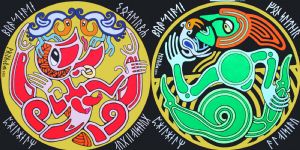| |

|

|
P164-P165 - DIPTYCH BRACTEATES OF THE GODS AND THEIR BIRDIES.
Painting Acrylic
Size: 37,4 x 74,8 inches
11800 USD
Description:
ART GALLERY / Here again are the theme of the Gods and bracteates developed in two of my latest paintings in spring 2012. They are presented as a diptych for aesthetic reasons, although they are each independent. The left, the P164 is entitled Bracteate Söderby two birds. It is named after the locality of Söderby Väsby in Swedish Uppland where this bracteate was found, knowing that it is at least three localities Söderby that carry the same name. It is more interesting that this type of design dates from the sixth to early seventh century, and this, in the northern regions of Europe. The man who was on the bracteate has undergone numerous "surgical" operations from your favorite artist, because he "transitioned" from man to woman, so to speak before the time a transsexual? Both birdies were very schematic with a strong connotation exotic, have become a little more realistic and curiously wrapped! As regards the runic writings rim from the top of the left in the direction of clockwise, this is simply the title of the table on three sides, the fourth meaning: PHILHELM. For purists of writing, I confess to having mixed for purely aesthetic and practical than the original alphabet of medieval runic variant including the Latin alphabet, which enabled me to find several missing letters, which did not exist at this early date. The table at right P165 headlined Bracteate von Sletner the bird, is also the same format. The name of the bracteate owes its origin to the Norwegian village named Sletner, but, you have probably already guessed! The pattern is a man, in fact a God, exaggeratedly contorted and with a single birdie that was not there originally. Remember that the theme of contortion and birds is recurrent in the iconography of the period and region. When the runic inscriptions from around, it is also the title of the table, you read from top left: bracteate, von Sletner, the bird, Philhelm. But for those who want to know more about bracteates, you have my previous paintings P153, P154 and P162 with their respective captions comments, and the following text as a reminder for forgetful of being unhappy. Happy reading again, knowing that I added a few details and shortened some passages, good luck.
Bracteate: A bracteate from the Latin "bractea" is a thin piece of metal. The imprint, struck by stamping on one side of a very thin metal blank is embossed on the face and hollow on the reverse. The term is used for both currencies for the medals. The pattern is always central, circular, and sometimes abstract for our understanding. The bracteate is almost always surrounded by a net cord or a series of zigzag friezes delicately worked. These jewels were manufactured primarily in Northern Europe, especially during the migration period we call the great invasions, or the Germanic Iron Age or Age of Migration in Sweden, which includes the Vendel period called from 550 to 793 AD, but the name is also used to produce parts later of silver produced in Central Europe in the early Middle Ages. It also describes parts of the neighboring Huns and the invasion of the Huns in India, in the style of Gupta and Roman coins. Their manufacture did not exceed 150 years between the late fifth century and the middle of the seventh, after the great influx of gold following the bags of Rome, that of 410 by the Visigoths and that of 455 by the Vandals. Their model was offered by the medallions struck gold as the Roman emperors of the fourth century. However the evolution of the figures move away quickly from the Roman model and recomposed according to an aesthetic extremely confusing, perhaps related to Norse mythology, but it seems equally imaginary? Even the runic inscriptions on some gold medals seem to have no meaning except the magic words? The bracteates are often taken for amulets, some served as penny to Charon, placed in the mouth of death! Regarding currencies bracteates, no runic legend is transcribed or translated in any way the coin legends in Latin, proof that the Norse did not attach any interest within the meaning of these, but only in their material aspect. Despite their "moneyform" appearance, the runic bracteates seem absolutely independent of runic coins that appear only four centuries later! Because now, there are women, on one of these paintings, it can be the goddess Freyja, by the will of your favorite artist. Freyja was a goddess Vane of the tribe of the Veneti. She was one of the most popular goddesses of Norse pantheon, the god of love and beauty, but also the intimacy, the attraction between people, wealth, magic, earth, the fertility and war. It was for the Nordic equivalent of Venus and Aphrodite. It is for this reason that Freyja was considered the first of the Valkyries. Richard Wagner implements it in "Der Ring des Nibelungen". When the man, he is obviously the god Odin, or Wodan in old-Saxon, or Wotan in Old High German (althochdeutsch).
|
|

|
|